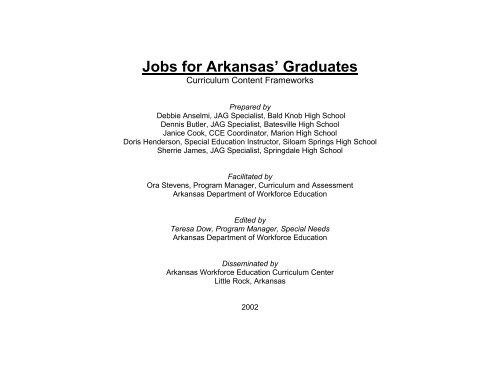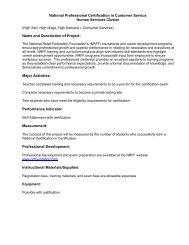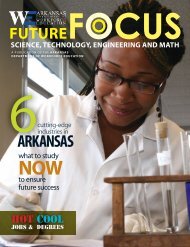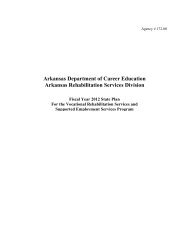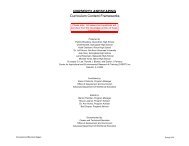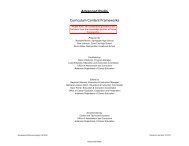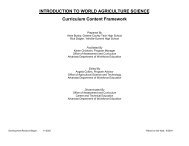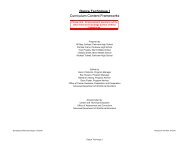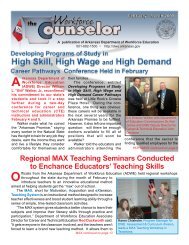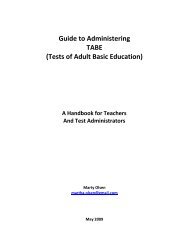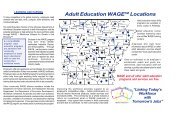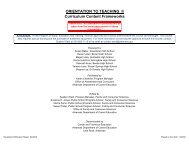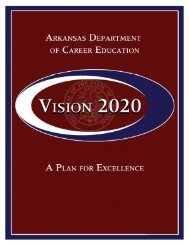Jobs for Arkansas' Graduates - Arkansas Department of Career ...
Jobs for Arkansas' Graduates - Arkansas Department of Career ...
Jobs for Arkansas' Graduates - Arkansas Department of Career ...
Create successful ePaper yourself
Turn your PDF publications into a flip-book with our unique Google optimized e-Paper software.
<strong>Jobs</strong> <strong>for</strong> <strong>Arkansas</strong>’ <strong>Graduates</strong><br />
Curriculum Content Frameworks<br />
Prepared by<br />
Debbie Anselmi, JAG Specialist, Bald Knob High School<br />
Dennis Butler, JAG Specialist, Batesville High School<br />
Janice Cook, CCE Coordinator, Marion High School<br />
Doris Henderson, Special Education Instructor, Siloam Springs High School<br />
Sherrie James, JAG Specialist, Springdale High School<br />
Facilitated by<br />
Ora Stevens, Program Manager, Curriculum and Assessment<br />
<strong>Arkansas</strong> <strong>Department</strong> <strong>of</strong> Work<strong>for</strong>ce Education<br />
Edited by<br />
Teresa Dow, Program Manager, Special Needs<br />
<strong>Arkansas</strong> <strong>Department</strong> <strong>of</strong> Work<strong>for</strong>ce Education<br />
Disseminated by<br />
<strong>Arkansas</strong> Work<strong>for</strong>ce Education Curriculum Center<br />
Little Rock, <strong>Arkansas</strong><br />
2002
Curriculum Content Framework<br />
<strong>Jobs</strong> <strong>for</strong> <strong>Arkansas</strong>’ <strong>Graduates</strong><br />
Grade Level: 11, 12<br />
Course Code: 493780 and 493790<br />
Course Description: <strong>Jobs</strong> <strong>for</strong> <strong>Arkansas</strong>’ <strong>Graduates</strong> can be utilized in any program <strong>of</strong> study and can count as credit toward a student’s vocational<br />
career focus/major. The program’s goal is to ensure student graduation (or GED) and prepare students <strong>for</strong> workplace success whether their career<br />
begins immediately upon high school graduation, entry into military service, or requires them to complete postsecondary education/training.<br />
Table <strong>of</strong> Contents<br />
Unit 1: <strong>Career</strong> Development.......................................................................................................................................................... 3<br />
Unit 2: Job Attainment ................................................................................................................................................................... 7<br />
Unit 3: Job Survival ..................................................................................................................................................................... 14<br />
Unit 4: Basic Competencies ........................................................................................................................................................ 22<br />
Unit 5: Leadership & Self-Development Competencies............................................................................................................... 27<br />
Unit 6: Personal Skills ................................................................................................................................................................. 34<br />
Page<br />
<strong>Jobs</strong> <strong>for</strong> <strong>Arkansas</strong>’ <strong>Graduates</strong><br />
Page 2
Unit 1: <strong>Career</strong> Development<br />
Terminology: Abilities, Aptitudes, <strong>Career</strong>, <strong>Career</strong> outlook, <strong>Career</strong> pathways, Clerical perception, Color discrimination, Competency,<br />
Dictionary <strong>of</strong> Occupational Titles, Eye-hand coordination, Finger dexterity, General learning ability, Interests, Job, Lifestyles,<br />
Motor coordination, Numerical aptitude, Occupational interests, Occupational Outlook Handbook, Rotating shift, Skills, Values,<br />
Verbal aptitude<br />
CAREER AND TECHNICAL SKILLS<br />
What the Student Should Be Able to Do<br />
ACADEMIC AND WORKPLACE SKILLS<br />
What the Instruction Should Rein<strong>for</strong>ce<br />
Knowledge Application Skill group Skill Description<br />
1.1.1 Identify personal interests, Personal<br />
Analyzes own knowledge, skills, and ability<br />
aptitudes and skills (A.1-1 & Management<br />
A.1-2)<br />
1.1 Define occupational<br />
interests, aptitudes,<br />
and abilities (A.1)<br />
<strong>Career</strong><br />
Awareness,<br />
Development,<br />
and Mobility<br />
1.1.2 Identify careers that may be<br />
<strong>of</strong> interest (A.1-3)<br />
Personal<br />
Management<br />
<strong>Career</strong><br />
Awareness,<br />
Development,<br />
and Mobility<br />
Explores career opportunities<br />
1.1.3 Provide in<strong>for</strong>mation<br />
regarding individual<br />
aptitudes (A.1-6)<br />
Personal<br />
Management<br />
<strong>Career</strong><br />
Awareness,<br />
Development,<br />
and Mobility<br />
Analyzes own knowledge, skills, and ability<br />
1.1.4 Read with comprehension<br />
{Reading, (A.1)}<br />
Foundation<br />
Reading<br />
Comprehends written in<strong>for</strong>mation <strong>for</strong> main<br />
ideas<br />
1.1.5 Demonstrate ability to read<br />
a graph {Math (A. 11)}<br />
Foundation<br />
Arithmetic/<br />
Mathematics<br />
Interprets charts, tables, graphs, and<br />
working drawings<br />
<strong>Jobs</strong> <strong>for</strong> <strong>Arkansas</strong>’ <strong>Graduates</strong><br />
Page 3
CAREER AND TECHNICAL SKILLS<br />
What the Student Should Be Able to Do<br />
ACADEMIC AND WORKPLACE SKILLS<br />
What the Instruction Should Rein<strong>for</strong>ce<br />
Knowledge Application Skill group Skill Description<br />
1.2.1 Utilize career reference Foundation Reading<br />
resources (A.2-1, A.2-2 &<br />
A.2-3)<br />
1.2 Illustrate the<br />
relationship <strong>of</strong><br />
interests, aptitudes,<br />
and abilities to<br />
appropriate<br />
occupations (A. 2)<br />
1.2.2 Demonstrate writing skills<br />
by relating interests,<br />
aptitudes, and abilities to<br />
career choices (A.2-4)<br />
Foundation<br />
Writing<br />
Uses written resources (books, dictionaries,<br />
directories) to obtain factual in<strong>for</strong>mation<br />
Presents own opinion in written <strong>for</strong>m in a<br />
clear, concise manner<br />
1.2.3 Demonstrate recall and<br />
retention {Reading (A.2)}<br />
Foundation<br />
Reading<br />
Comprehends written in<strong>for</strong>mation <strong>for</strong> main<br />
ideas<br />
1.3 Discuss how values<br />
change and affect job<br />
choices (A. 3)<br />
1.2.4 Use basic principles <strong>of</strong><br />
algebra and arithmetic<br />
{Math (A.2)}<br />
1.3.1 Define values<br />
1.3.2 Identify desired lifestyle,<br />
and relate to selected<br />
occupations<br />
Foundation<br />
Foundation<br />
Personal<br />
Management<br />
Skills<br />
Arithmetic/<br />
Mathematics<br />
Speaking<br />
<strong>Career</strong><br />
Awareness<br />
Uses basic algebraic symbols, terms,<br />
principles<br />
Communicates a thought, idea, or fact in<br />
spoken <strong>for</strong>m<br />
Analyzes impact <strong>of</strong> work on individual and<br />
family life<br />
1.3.3 Discuss how people,<br />
institutions, and other<br />
external things affect values<br />
and behavior<br />
Personal<br />
Management<br />
Skills<br />
<strong>Career</strong><br />
Awareness<br />
Identifies continuing changes in male/female<br />
roles at home and work<br />
1.3.4 Select a job description that<br />
aligns with various values<br />
Personal<br />
Management<br />
Skills<br />
<strong>Career</strong><br />
Awareness<br />
Develops skills to locate, evaluate, and<br />
interpret career in<strong>for</strong>mation<br />
1.3.5 Give solutions to problems<br />
when conflicts in values<br />
occur<br />
Thinking<br />
Problem<br />
Solving<br />
Devises and implements a plan <strong>of</strong> action to<br />
resolve problem<br />
<strong>Jobs</strong> <strong>for</strong> <strong>Arkansas</strong>’ <strong>Graduates</strong><br />
Page 4
CAREER AND TECHNICAL SKILLS<br />
What the Student Should Be Able to Do<br />
ACADEMIC AND WORKPLACE SKILLS<br />
What the Instruction Should Rein<strong>for</strong>ce<br />
Knowledge Application Skill group Skill Description<br />
1.4.1 Link interests to a specific Personal<br />
Analyzes own knowledge, skills, and ability<br />
career pathway (A.4-1, A.4- Management<br />
2 & A.4-3)<br />
1.4 Identify jobs that<br />
represent all career<br />
pathways (A. 4)<br />
<strong>Career</strong><br />
Awareness,<br />
Development,<br />
and Mobility<br />
1.4.2 Demonstrate recall,<br />
retention, inferences, and<br />
conclusions {Reading (A.4)}<br />
Foundation<br />
Reading<br />
Draws conclusions from what is read<br />
1.5 Relate interests,<br />
values, and skills to<br />
selected jobs (A.5)<br />
1.4.3 Manipulate employment<br />
data to compare units <strong>of</strong><br />
measure as they relate to<br />
time and wages {Math<br />
(A.4)}<br />
1.5.1 Interview people in various<br />
careers (A.5-5)<br />
1.5.2 Discuss individual career<br />
choices (A.5-6)<br />
Foundation<br />
Foundation<br />
Foundation<br />
Arithmetic/<br />
Mathematics<br />
Speaking<br />
Speaking<br />
Uses quantitative data to construct logical<br />
explanations <strong>for</strong> real world situations<br />
Asks questions to obtain in<strong>for</strong>mation<br />
Communicates a thought, idea, or fact in<br />
spoken <strong>for</strong>m<br />
1.5.3 Read <strong>for</strong> comprehension<br />
and recall {Reading (A.5)}<br />
Foundation<br />
Reading<br />
Comprehends written in<strong>for</strong>mation <strong>for</strong> main<br />
ideas<br />
1.5.4 Place items in numerical<br />
order {Math (A.5)}<br />
Foundation<br />
Arithmetic/<br />
Mathematics<br />
Uses basic numerical concepts in practical<br />
situations<br />
<strong>Jobs</strong> <strong>for</strong> <strong>Arkansas</strong>’ <strong>Graduates</strong><br />
Page 5
CAREER AND TECHNICAL SKILLS<br />
What the Student Should Be Able to Do<br />
ACADEMIC AND WORKPLACE SKILLS<br />
What the Instruction Should Rein<strong>for</strong>ce<br />
Knowledge Application Skill group Skill Description<br />
1.6.1 Express career<br />
Personal<br />
considerations (A.6-1) Management<br />
1.6 Identify conditions and<br />
specifications <strong>of</strong><br />
various jobs (A. 6)<br />
<strong>Career</strong><br />
Awareness,<br />
Development,<br />
and Mobility<br />
Sets well-defined and realistic<br />
personal/career goals (short-term and longterm)<br />
1.6.2 Gather in<strong>for</strong>mation about<br />
jobs in which students are<br />
interested (A.6-3)<br />
Personal<br />
Management<br />
<strong>Career</strong><br />
Awareness,<br />
Development<br />
and Mobility<br />
Develops skills to locate, evaluate, and<br />
interpret career in<strong>for</strong>mation<br />
1.6.3 Recognize commonly<br />
stated job qualifications<br />
(A.6-2)<br />
Personal<br />
Management<br />
<strong>Career</strong><br />
Awareness,<br />
Development,<br />
and Mobility<br />
Identifies education and training needed to<br />
achieve goals<br />
1.6.4 Gather in<strong>for</strong>mation <strong>for</strong> an<br />
opportunity to shadow a<br />
worker in order to identify<br />
job competencies (A.6-4)<br />
Personal<br />
Management<br />
<strong>Career</strong><br />
Awareness,<br />
Development,<br />
and Mobility<br />
Explores career opportunities<br />
1.6.5 Utilize several sources <strong>of</strong><br />
in<strong>for</strong>mation to investigate<br />
job competencies (A.6-5)<br />
Personal<br />
Management<br />
<strong>Career</strong><br />
Awareness,<br />
Development,<br />
and Mobility<br />
Explores career opportunities<br />
1.6.6 Apply the in<strong>for</strong>mation<br />
learned (A.6-6)<br />
Personal<br />
Management<br />
<strong>Career</strong><br />
Awareness,<br />
Development,<br />
and Mobility<br />
Monitors progress toward goal attainment<br />
1.6.7 Read with comprehension<br />
{Reading (A.6)}<br />
Foundation<br />
Reading<br />
Comprehends written in<strong>for</strong>mation <strong>for</strong> main<br />
ideas<br />
1.6.8 Calculate and convert units<br />
<strong>of</strong> measure {Math (A.6)}<br />
Foundation<br />
Arithmetic/<br />
Mathematics<br />
Calculates measurements taken from<br />
measuring<br />
<strong>Jobs</strong> <strong>for</strong> <strong>Arkansas</strong>’ <strong>Graduates</strong><br />
Page 6
Unit 2: Job Attainment<br />
Terminology:<br />
Body language, Chronological resume, Classified ad, Cooperative, Date <strong>of</strong> birth (DOB), Education, Employer, Employment<br />
agency, Family, Former Employer, Initiative, Job leads, Letter <strong>of</strong> application/Cover letter, Military classification, N/A, Negative<br />
attitude, Networking, Online application, Personal in<strong>for</strong>mation, Positive attitude, Private employment agency, Probation, Public<br />
employment agency, Qualities, Reference, Resume, Skills/Functional resume, WPM<br />
CAREER AND TECHNICAL SKILLS<br />
What the Student Should Be Able to Do<br />
ACADEMIC AND WORKPLACE SKILLS<br />
What the Instruction Should Rein<strong>for</strong>ce<br />
Knowledge Application Skill group Skill Description<br />
2.1.1 Define resume, and identify Foundation Speaking<br />
its chief functions (B.7-1)<br />
2.1 Identify the general<br />
rules when writing a<br />
resume (B.7)<br />
2.1.2 Identify the standard resume<br />
<strong>for</strong>mat and its components<br />
(B.7-1)<br />
Thinking<br />
Skills<br />
Decision Making<br />
Communicates a thought, idea, or fact in<br />
spoken <strong>for</strong>m<br />
Comprehends ideas and concepts related<br />
to writing a resume<br />
2.1.3 Identify errors on a resume,<br />
and state why they are<br />
errors (B.7-2)<br />
Thinking<br />
Skills<br />
Decision Making<br />
Identifies pros and cons to assist in<br />
decision making<br />
2.1.4 Write a resume using<br />
standard chronological<br />
<strong>for</strong>mat (B.7-1)<br />
Foundation<br />
Writing<br />
Organizes in<strong>for</strong>mation in an appropriate<br />
<strong>for</strong>mat<br />
2.1.5 Read <strong>for</strong> comprehension<br />
{Reading (B.7)}<br />
Foundation<br />
Reading<br />
Comprehends written in<strong>for</strong>mation and<br />
applies it to a task<br />
2.1.6 Practice working with time<br />
{Math (B.7)}<br />
Foundation<br />
Arithmetic/<br />
Mathematics<br />
Applies computation skills related to<br />
working with time<br />
<strong>Jobs</strong> <strong>for</strong> <strong>Arkansas</strong>’ <strong>Graduates</strong><br />
Page 7
CAREER AND TECHNICAL SKILLS<br />
What the Student Should Be Able to Do<br />
ACADEMIC AND WORKPLACE SKILLS<br />
What the Instruction Should Rein<strong>for</strong>ce<br />
Knowledge Application Skill group Skill Description<br />
2.2.1 Identify sources to look <strong>for</strong> Thinking Knowing how to<br />
job leads (B.8-1, B.8-2, &<br />
Learn<br />
B.8-5)<br />
2.2 Identify the<br />
components <strong>of</strong> the job<br />
search process (B.8)<br />
Uses available resources to acquire new<br />
skills or improve existing skills<br />
2.2.2 Read and understand the<br />
abbreviations in want ads<br />
(B.8-3)<br />
Foundation<br />
Reading<br />
Analyzes and applies what has been read<br />
to a specific task<br />
2.2.3 Read and interpret want ads<br />
(B.8-4)<br />
Thinking<br />
Problem Solving<br />
Draws conclusions from what is read, and<br />
gives possible solutions<br />
2.2.4 Read <strong>for</strong> comprehension<br />
{Reading (B.8)}<br />
Foundation<br />
Reading<br />
Comprehends written in<strong>for</strong>mation, and<br />
applies knowledge to a task<br />
2.3 Explain the purposes<br />
and components <strong>of</strong> a<br />
letter <strong>of</strong> application<br />
2.2.5 Practice multiplication and<br />
division {Math (B.8)}<br />
2.3.1 Explain the purpose <strong>of</strong> a<br />
letter <strong>of</strong> application (B.9-5)<br />
2.3.2 Identify the components in a<br />
letter <strong>of</strong> application (B.9-3 &<br />
B.9-5)<br />
Foundation<br />
Thinking<br />
Foundation<br />
Arithmetic/<br />
Mathematics<br />
Reasoning<br />
Reading<br />
Applies addition, subtraction,<br />
multiplication, and division to real-world<br />
situations<br />
Comprehends ideas and concepts related<br />
to letters <strong>of</strong> application<br />
Identifies relevant details, facts, and<br />
specifications<br />
2.3.3 Compose a letter <strong>of</strong><br />
application (B.9-1, B.9-2,<br />
B.9-3, B.9-4, & B.9-5)<br />
Foundation<br />
Writing<br />
Uses language, style, organization, and<br />
<strong>for</strong>mat appropriate to subject matter,<br />
purpose, and audience<br />
2.3.4 Address an envelope (B.9-4)<br />
Foundation<br />
Writing<br />
Uses language, style, organization, and<br />
<strong>for</strong>mat appropriate to subject matter,<br />
purpose, and audience<br />
2.3.5 Read with comprehension<br />
and recall {Reading (B.9)}<br />
Foundation<br />
Reading<br />
Comprehends written in<strong>for</strong>mation and<br />
applies knowledge to a task<br />
2.3.6 Solve multiplication, division<br />
and weigh problems {Math<br />
(B.9)}<br />
Foundation<br />
<strong>Jobs</strong> <strong>for</strong> <strong>Arkansas</strong>’ <strong>Graduates</strong><br />
Page 8<br />
Arithmetic/<br />
Mathematics<br />
Uses basic numerical concepts in practical<br />
situations
CAREER AND TECHNICAL SKILLS<br />
What the Student Should Be Able to Do<br />
ACADEMIC AND WORKPLACE SKILLS<br />
What the Instruction Should Rein<strong>for</strong>ce<br />
Knowledge Application Skill group Skill Description<br />
2.4 Identify proper<br />
procedures in using a<br />
telephone (B.10)<br />
2.4.1 Discuss reasons <strong>for</strong> good<br />
telephone skills when<br />
conducting a job search<br />
Thinking Creative Thinking Forms opinions<br />
2.4.2 Inquire about a job, and<br />
acquire an interview (B.10-1,<br />
B.10-2, B.10-3, & B.10-4)<br />
Foundation<br />
Speaking<br />
Organizes ideas, and communicates oral<br />
messages to listeners<br />
2.4.3 Utilizing the telephone,<br />
follow up on an interview,<br />
and accept a job (B.10-4)<br />
Foundation<br />
Speaking<br />
Participates in conversation, discussion,<br />
and group presentations<br />
2.4.4 Read <strong>for</strong> comprehension<br />
and recall {Reading (B.10)}<br />
Foundation<br />
Reading<br />
Comprehends written in<strong>for</strong>mation, and<br />
applies it to a task<br />
2.4.5 Use a diagram, {Math<br />
(B.10)}<br />
Foundation<br />
Arithmetic/<br />
Mathematics<br />
Comprehends mathematical ideas and<br />
concepts related to using a diagram<br />
<strong>Jobs</strong> <strong>for</strong> <strong>Arkansas</strong>’ <strong>Graduates</strong><br />
Page 9
CAREER AND TECHNICAL SKILLS<br />
What the Student Should Be Able to Do<br />
ACADEMIC AND WORKPLACE SKILLS<br />
What the Instruction Should Rein<strong>for</strong>ce<br />
Knowledge Application Skill group Skill Description<br />
2.5.1 Understand words<br />
Foundation Reading<br />
commonly used on an<br />
application <strong>for</strong>m (B.11-1)<br />
2.5 Discuss reasons and<br />
procedures in<br />
completing an<br />
application (B.11<br />
2.5.2 Identify errors on an<br />
application, and correct them<br />
Thinking<br />
Problem Solving<br />
Applies/Understands technical words that<br />
pertain to subject<br />
Draws conclusions from observations,<br />
evaluates conditions, and gives possible<br />
solutions<br />
2.5.3 Identify the sections <strong>of</strong> an<br />
application <strong>for</strong>m (B.11-1)<br />
Foundation<br />
Reading<br />
Comprehends written in<strong>for</strong>mation, and<br />
applies it to a task<br />
2.5.4 Complete an application<br />
<strong>for</strong>m (B.11-2 & B.11-3)<br />
Foundation<br />
Writing<br />
Prepares a complex document in a<br />
concise manner<br />
2.5.5 Read <strong>for</strong> comprehension<br />
and recall {Reading (B.11)}<br />
Foundation<br />
Reading<br />
Comprehends written in<strong>for</strong>mation, and<br />
applies it to a task<br />
2.5.6 Practice multiplication,<br />
division, and percentages<br />
{Math (B.11)}<br />
Foundation<br />
Arithmetic/<br />
Mathematics<br />
Applies addition, subtraction,<br />
multiplication, and division to real-world<br />
situations<br />
<strong>Jobs</strong> <strong>for</strong> <strong>Arkansas</strong>’ <strong>Graduates</strong><br />
Page 10
CAREER AND TECHNICAL SKILLS<br />
What the Student Should Be Able to Do<br />
ACADEMIC AND WORKPLACE SKILLS<br />
What the Instruction Should Rein<strong>for</strong>ce<br />
Knowledge Application Skill group Skill Description<br />
2.6.1 Identify types <strong>of</strong> employment Thinking Decision Making<br />
tests (B.12-1, B.12-2, B.12-<br />
3, & B.12-4)<br />
2.6 Discuss reasons why<br />
employment tests are<br />
given (B.12)<br />
Comprehends ideas and concepts related<br />
to employment testing<br />
2.6.2 Complete various types <strong>of</strong><br />
employment tests (B.12-1,<br />
B.12-2, B.12-3, &<br />
B.12-4)<br />
Thinking<br />
Knowing how to<br />
Learn<br />
Processes new in<strong>for</strong>mation as related to<br />
workplace<br />
2.6.3 Read <strong>for</strong> comprehension<br />
and recall {Reading (B.12)}<br />
Foundation<br />
Reading<br />
Comprehends written in<strong>for</strong>mation, and<br />
applies it to a task<br />
2.6.4 Demonstrate the ability to<br />
read a table and per<strong>for</strong>m<br />
addition, subtraction, and<br />
multiplication {Math (B.12)}<br />
Thinking<br />
Reasoning<br />
Uses logic to draw conclusions from<br />
available in<strong>for</strong>mation<br />
<strong>Jobs</strong> <strong>for</strong> <strong>Arkansas</strong>’ <strong>Graduates</strong><br />
Page 11
CAREER AND TECHNICAL SKILLS<br />
What the Student Should Be Able to Do<br />
ACADEMIC AND WORKPLACE SKILLS<br />
What the Instruction Should Rein<strong>for</strong>ce<br />
Knowledge Application Skill group Skill Description<br />
2.7.1 Discuss how to prepare <strong>for</strong> Thinking Reasoning Applies rules and principles to a new<br />
the interview (B.13-1)<br />
situation<br />
2.7 Discuss the purposes<br />
<strong>of</strong> job interviews<br />
(B.13)<br />
2.7.2 Discuss stages <strong>of</strong> the<br />
interview process<br />
Thinking<br />
Reasoning<br />
Comprehends ideas and concepts related<br />
to the job interview<br />
2.7.3 Identify common<br />
interviewing mistakes<br />
Thinking<br />
Problem Solving<br />
Identifies possible reasons <strong>for</strong> problem<br />
2.7.4 Demonstrate proper body<br />
language <strong>for</strong> an interview<br />
(B.13-3)<br />
Personal<br />
Management<br />
Self-esteem<br />
Presents positive image <strong>of</strong> personal<br />
attitudes and abilities<br />
2.7.5 Answer questions<br />
frequently asked in an<br />
interview (B.13-2, B.13-4)<br />
Foundation<br />
Speaking<br />
Communicates a thought, idea, or fact in<br />
spoken <strong>for</strong>m<br />
2.7.6 Identify questions applicant<br />
should ask employer<br />
during the interview (B.13-<br />
4)<br />
Foundation<br />
Speaking<br />
Asks questions to obtain in<strong>for</strong>mation<br />
2.7.7 Discuss ethical issues<br />
related to interviewing<br />
Personal<br />
Management<br />
Integrity/Honesty/<br />
Work Ethic<br />
Follows established rules, regulations, and<br />
policies<br />
2.7.8 Role-play an interview <strong>for</strong> a<br />
job (B.13-5)<br />
Foundation<br />
Speaking<br />
Participates in conversation, discussion,<br />
and group presentations<br />
2.7.9 Identify components <strong>of</strong> a<br />
post-interview followup<br />
letter (B.13-6)<br />
Foundation<br />
Writing<br />
Prepares a complex document in a<br />
concise manner<br />
<strong>Jobs</strong> <strong>for</strong> <strong>Arkansas</strong>’ <strong>Graduates</strong><br />
Page 12
CAREER AND TECHNICAL SKILLS<br />
What the Student Should Be Able to Do<br />
ACADEMIC AND WORKPLACE SKILLS<br />
What the Instruction Should Rein<strong>for</strong>ce<br />
Knowledge Application Skill group Skill Description<br />
2.7 Cont. 2.7.9 Read <strong>for</strong> comprehension<br />
and recall {Reading (B.13)}<br />
Foundation Reading<br />
Comprehends written in<strong>for</strong>mation, and<br />
applies it to a task<br />
2.7.10 Place items in numerical<br />
order {Math (B.13)}<br />
Foundation<br />
Arithmetic/<br />
Mathematics<br />
Comprehends mathematical ideas and<br />
concepts related to job interview<br />
<strong>Jobs</strong> <strong>for</strong> <strong>Arkansas</strong>’ <strong>Graduates</strong><br />
Page 13
Unit 3: Job Survival<br />
Terminology: Accessories, Appearance, Attitude, Bold, Business casual, Competent, Comprehension, Corporate culture, Counter <strong>of</strong>fer,<br />
Courteous, Culture, Customer relations, Disloyalty, Employee, Employer, Exit interview, Expectations, First impression,<br />
Gossip, Grooming, Human relations, Hygiene, Initiative, Interpersonal skills, Interview, Letter <strong>of</strong> resignation, Listening,<br />
Manners, Optimistic, Orientation, Personality, Pessimistic, Policies, Probationary period, Pr<strong>of</strong>essional appearance, Reliable,<br />
Resignation, Respectful, Self-centered, Supervisor, Teamwork, Thoughtful, Time management<br />
CAREER AND TECHNICAL SKILLS<br />
What the Student Should Be Able to Do<br />
ACADEMIC AND WORKPLACE SKILLS<br />
What the Instruction Should Rein<strong>for</strong>ce<br />
Knowledge Application Skill group Skill Description<br />
3.1 Identify what is meant by<br />
appropriate appearance<br />
(C.14)<br />
3.1.1 State why<br />
appearance is<br />
important when<br />
looking <strong>for</strong> a job<br />
Personal<br />
Management<br />
Integrity/<br />
Honesty/Work<br />
Ethic<br />
Describes desirable worker characteristics<br />
3.1.2 Describe<br />
appropriate dress<br />
<strong>for</strong> a job interview<br />
(C.14.2 & C-14-3)<br />
Personal<br />
Management<br />
Integrity/<br />
Honesty/ Work<br />
Ethic<br />
Describes desirable worker characteristics<br />
3.1.3 State why<br />
appropriate<br />
appearance and<br />
dress are<br />
important once<br />
you have the job<br />
(C.14.2 & C.14-3)<br />
Personal<br />
Management<br />
Organizational<br />
Effectiveness<br />
Identifies characteristics desired by organization<br />
3.1.4 Describe the<br />
types <strong>of</strong> dress<br />
appropriate <strong>for</strong><br />
different positions<br />
{Reading (C.14)}<br />
Foundation<br />
Reading<br />
Follows written directions<br />
<strong>Jobs</strong> <strong>for</strong> <strong>Arkansas</strong>’ <strong>Graduates</strong><br />
Page 14
CAREER AND TECHNICAL SKILLS<br />
What the Student Should Be Able to Do<br />
ACADEMIC AND WORKPLACE SKILLS<br />
What the Instruction Should Rein<strong>for</strong>ce<br />
Knowledge Application Skill group Skill Description<br />
3.1 Cont. 3.1.5 Calculate<br />
percentages, and<br />
demonstrate<br />
pr<strong>of</strong>iciency in<br />
adding and<br />
subtracting<br />
monetary<br />
amounts {Math<br />
(C.14)}<br />
Foundation Arithmetic/<br />
Mathematics<br />
Converts percentages to dollar amounts<br />
<strong>Jobs</strong> <strong>for</strong> <strong>Arkansas</strong>’ <strong>Graduates</strong><br />
Page 15
CAREER AND TECHNICAL SKILLS<br />
What the Student Should Be Able to Do<br />
ACADEMIC AND WORKPLACE SKILLS<br />
What the Instruction Should Rein<strong>for</strong>ce<br />
Knowledge Application Skill group Skill Description<br />
3.2 Identify qualities and<br />
characteristics that<br />
employers expect <strong>of</strong><br />
employees (C.15)<br />
3.2.1 Name qualities<br />
that employers<br />
expect from their<br />
employees (C.15-<br />
3 & C.15-4)<br />
Personal<br />
Management<br />
Organizational<br />
Effectiveness<br />
Identifies characteristics desired by organization<br />
3.2.2 Discuss what a<br />
person can expect<br />
from an employer<br />
(C.15-5)<br />
Personal<br />
Management<br />
Organizational<br />
Effectiveness<br />
Adapts to the organization’s goals, values,<br />
culture, and traditional modes <strong>of</strong> operation<br />
3.2.3 Name reasons<br />
workers lose their<br />
jobs (C.15-2)<br />
Personal<br />
Management<br />
Integrity/<br />
Honesty/Work<br />
Ethic<br />
Describes/Explains significance <strong>of</strong> integrity,<br />
honesty, and work ethic<br />
3.2.4 Demonstrate<br />
retention and<br />
recall {Reading<br />
(C.15)}<br />
Foundation<br />
Reading<br />
Comprehends written in<strong>for</strong>mation, and applies it<br />
to a task<br />
3.2.5 Arrive at a<br />
verifiable rule or<br />
set <strong>of</strong> rules to<br />
handle all addition<br />
situations with<br />
signed numbers<br />
{Math (C.15)}<br />
Foundation<br />
Arithmetic/<br />
Mathematics<br />
Applies a mathematical <strong>for</strong>mula to solve a<br />
problem<br />
<strong>Jobs</strong> <strong>for</strong> <strong>Arkansas</strong>’ <strong>Graduates</strong><br />
Page 16
CAREER AND TECHNICAL SKILLS<br />
What the Student Should Be Able to Do<br />
ACADEMIC AND WORKPLACE SKILLS<br />
What the Instruction Should Rein<strong>for</strong>ce<br />
Knowledge Application Skill group Skill Description<br />
3.3 Identify problems <strong>of</strong> new<br />
employees (C.16)<br />
3.3.1 Identify problems<br />
that new<br />
employees might<br />
encounter on the<br />
job (C.16-2, C.16-<br />
4, & C.16-5)<br />
Thinking Problem<br />
Solving<br />
Recognizes/Defines problem<br />
3.3.2 Discuss solutions<br />
to the problems<br />
that new<br />
employees might<br />
encounter on the<br />
job (C.16-2 &<br />
C.16-5)<br />
Thinking<br />
Problem<br />
Solving<br />
Devises and implements a plan <strong>of</strong> action to<br />
resolve problem<br />
3.3.3 Read <strong>for</strong><br />
comprehension<br />
and recall<br />
{Reading (C.16)}<br />
Foundation<br />
Reading<br />
Comprehends written in<strong>for</strong>mation, and applies it<br />
to a task<br />
3.3.4 Practice reading a<br />
ruler and adding<br />
and subtracting<br />
fractions {Math<br />
(C.16)}<br />
Foundation<br />
Arithmetic<br />
Calculates different units <strong>of</strong> measurement<br />
<strong>Jobs</strong> <strong>for</strong> <strong>Arkansas</strong>’ <strong>Graduates</strong><br />
Page 17
CAREER AND TECHNICAL SKILLS<br />
What the Student Should Be Able to Do<br />
ACADEMIC AND WORKPLACE SKILLS<br />
What the Instruction Should Rein<strong>for</strong>ce<br />
Knowledge Application Skill group Skill Description<br />
3.4.1 Identify strategies Personal Responsibility<br />
<strong>for</strong> time<br />
Management<br />
management<br />
(C.17-5)<br />
3.4 Identify ways to manage<br />
time (C.17)<br />
Comprehends ideas and concepts related to<br />
personal time management<br />
3.4.2 Practice effective<br />
time management<br />
strategies (C.17-6)<br />
Personal<br />
Management<br />
Responsibility<br />
Pays close attention to details<br />
3.4.3 Determine how to<br />
improve time<br />
management<br />
(C.17-1, C.17-2, &<br />
C.17-3)<br />
Thinking<br />
Reasoning<br />
Uses logic to draw conclusions from available<br />
in<strong>for</strong>mation<br />
3.4.4 Discuss ways to<br />
utilize time to<br />
accomplish goals<br />
(C.17-4 & C.17-5)<br />
Thinking<br />
Decision<br />
Making<br />
Evaluates in<strong>for</strong>mation/data to make best decision<br />
3.4.5 Read <strong>for</strong><br />
comprehension<br />
and recall<br />
{Reading (C.17)}<br />
Foundation<br />
Reading<br />
Comprehends written in<strong>for</strong>mation and applies it<br />
to a task<br />
3.4.6 Read a schedule,<br />
and discuss how<br />
to per<strong>for</strong>m basic<br />
time calculations<br />
{Math (C.17)}<br />
Foundation<br />
Arithmetic/<br />
Mathematics<br />
Interprets charts, tables, graphs, and working<br />
drawings<br />
<strong>Jobs</strong> <strong>for</strong> <strong>Arkansas</strong>’ <strong>Graduates</strong><br />
Page 18
CAREER AND TECHNICAL SKILLS<br />
What the Student Should Be Able to Do<br />
ACADEMIC AND WORKPLACE SKILLS<br />
What the Instruction Should Rein<strong>for</strong>ce<br />
Knowledge Application Skill group Skill Description<br />
3.5.1 Discuss why it is Foundation Listening<br />
important to follow<br />
directions (C.18-1<br />
& C.18-4)<br />
3.5 Identify the reasons <strong>for</strong><br />
following directions (C.18)<br />
Comprehends ideas and concepts related to<br />
following directions<br />
3.5.2 Follow verbal<br />
directions (C.18-2<br />
& C.18-3)<br />
Foundation<br />
Listening<br />
Receives and interprets verbal messages<br />
3.5.3 Give directions<br />
using a map<br />
(C.18-6)<br />
Foundation<br />
Speaking<br />
Organizes ideas, and communicates oral<br />
messages to listeners<br />
3.5.4 Demonstrate<br />
recall and<br />
retention {Reading<br />
(C.18)}<br />
Foundation<br />
Reading<br />
Comprehends written in<strong>for</strong>mation, and applies it<br />
to a task<br />
3.5.5 Devise a method<br />
to calculate<br />
distance {Math<br />
(C.18)}<br />
Foundation<br />
Arithmetic/<br />
Mathematics<br />
Applies a mathematical <strong>for</strong>mula to solve a<br />
problem<br />
<strong>Jobs</strong> <strong>for</strong> <strong>Arkansas</strong>’ <strong>Graduates</strong><br />
Page 19
CAREER AND TECHNICAL SKILLS<br />
What the Student Should Be Able to Do<br />
ACADEMIC AND WORKPLACE SKILLS<br />
What the Instruction Should Rein<strong>for</strong>ce<br />
Knowledge Application Skill group Skill Description<br />
3.6.1 Identify factors Thinking Reasoning<br />
important <strong>for</strong><br />
getting along with<br />
others (C.19-1,<br />
C.19-2, & C.19-3)<br />
3.6 Identify ways to<br />
demonstrate effective<br />
human relations (C.19)<br />
Comprehends ideas and concepts related to<br />
human relations<br />
3.6.2 Identify solutions<br />
to problems on the<br />
job<br />
Thinking<br />
Problem<br />
Solving<br />
Draws conclusions from observations, evaluates<br />
conditions, and gives possible solutions<br />
3.6.3 Demonstrate<br />
actions and<br />
behaviors <strong>of</strong><br />
effective human<br />
relations (C.19-4 &<br />
C.19-5)<br />
Interpersonal<br />
Teamwork<br />
Demonstrates understanding, friendliness,<br />
adaptability, empathy, and politeness in new and<br />
ongoing group settings<br />
3.6.4 Read <strong>for</strong><br />
comprehension<br />
and recall<br />
{Reading (C.19)}<br />
Foundation<br />
Reading<br />
Comprehends written in<strong>for</strong>mation, and applies it<br />
to a task<br />
3.6.5 Practice addition,<br />
subtraction,<br />
multiplication, and<br />
division {Math<br />
(C.19)}<br />
Foundation<br />
Arithmetic/<br />
Mathematics<br />
Applies addition, subtraction, multiplication, and<br />
division to real-world situations<br />
<strong>Jobs</strong> <strong>for</strong> <strong>Arkansas</strong>’ <strong>Graduates</strong><br />
Page 20
CAREER AND TECHNICAL SKILLS<br />
What the Student Should Be Able to Do<br />
ACADEMIC AND WORKPLACE SKILLS<br />
What the Instruction Should Rein<strong>for</strong>ce<br />
Knowledge Application Skill group Skill Description<br />
3.7.1 Identify how an Thinking Problem<br />
employee should<br />
Solving<br />
resign from a job<br />
(C.20-2 & C.20-3)<br />
3.7 Discuss appropriate<br />
techniques <strong>for</strong> leaving a<br />
job (C.20)<br />
Devises and implements a plan <strong>of</strong> action to<br />
resolve problem<br />
3.7.2 Demonstrate the<br />
appropriate<br />
technique <strong>for</strong><br />
resigning orally<br />
from a job (C.20-<br />
1)<br />
Foundation<br />
Speaking<br />
Organizes ideas, and communicates oral<br />
messages to listeners<br />
3.7.3 Write a letter <strong>of</strong><br />
resignation (C.20-<br />
4)<br />
Foundation<br />
Writing<br />
Composes and creates document—letters,<br />
manuals, reports, proposals, graphs, flow charts<br />
3.7.4 Read with<br />
comprehension<br />
{Reading (C.20)}<br />
Foundation<br />
Reading<br />
Comprehends written in<strong>for</strong>mation, and applies it<br />
to a task<br />
3.7.5 Practice<br />
percentages {Math<br />
(C.20)}<br />
Foundation<br />
Arithmetic/<br />
Mathematics<br />
Calculates percentages, ratios, proportions,<br />
decimals, and common fractions<br />
<strong>Jobs</strong> <strong>for</strong> <strong>Arkansas</strong>’ <strong>Graduates</strong><br />
Page 21
Unit 4: Basic Competencies<br />
Terminology: Angle, Area, Cause and effect, Circumference, Communication, Compare, Complete sentence, Comprehension, Contract,<br />
Coordinates, Entertain, Enunciation, Feedback, Fragment, Generalization, Inference, Inflection, In<strong>for</strong>m, Inspire, Message,<br />
Perimeter, Persuade, Prefixes, Pronunciation, Pythagorean theorem, Receiver, Right triangle, Sender, Suffixes, Summary<br />
CAREER AND TECHNICAL SKILLS<br />
What the Student Should Be Able to Do<br />
ACADEMIC AND WORKPLACE SKILLS<br />
What the Instruction Should Rein<strong>for</strong>ce<br />
Knowledge Application Skill group Skill Description<br />
4.1.1 Name elements Foundation Speaking<br />
that complete the<br />
communication<br />
process (D.21-1 &<br />
D.21-2)<br />
4.1 Describe verbal<br />
communication (D.21)<br />
Communicates a thought, idea, or fact in spoken<br />
<strong>for</strong>m<br />
4.1.2 Diagram the<br />
communication<br />
cycle<br />
Foundation<br />
Speaking<br />
Communicates a thought, idea, or fact in spoken<br />
<strong>for</strong>m<br />
4.1.3 Give reasons why<br />
listening is<br />
important on the<br />
job (D.21-3 &<br />
D.21-4)<br />
Thinking<br />
Decision<br />
Making<br />
Comprehends ideas and concepts related to<br />
listening<br />
4.1.4 Show<br />
understanding <strong>of</strong><br />
verbal instructions<br />
Foundation<br />
Speaking<br />
Communicates a thought, idea, or fact in spoken<br />
<strong>for</strong>m<br />
<strong>Jobs</strong> <strong>for</strong> <strong>Arkansas</strong>’ <strong>Graduates</strong><br />
Page 22
CAREER AND TECHNICAL SKILLS<br />
What the Student Should Be Able to Do<br />
ACADEMIC AND WORKPLACE SKILLS<br />
What the Instruction Should Rein<strong>for</strong>ce<br />
Knowledge Application Skill group Skill Description<br />
4.2.1 Read <strong>for</strong><br />
Foundation Reading<br />
comprehension<br />
and recall (D.22-<br />
1)<br />
4.2 Describe written<br />
communication (D.22)<br />
Comprehends written in<strong>for</strong>mation, and applies it to<br />
a task<br />
4.2.1 Make inferences,<br />
and draw<br />
conclusions (D.22-<br />
2)<br />
Foundation<br />
Reading<br />
Draws conclusions from what is read<br />
4.2.2 Make<br />
generalizations<br />
Foundation<br />
Reading<br />
Draws conclusions from what is read<br />
4.2.3 Summarize a<br />
reading passage<br />
(D.22-3)<br />
Foundation<br />
Reading<br />
Draws conclusions from what is read<br />
4.2.4 Identify causeand-effect<br />
relationships in a<br />
passage (D.22-4 &<br />
D.22-5)<br />
Foundation<br />
Reading<br />
Identifies relevant details, facts, and specifications<br />
<strong>Jobs</strong> <strong>for</strong> <strong>Arkansas</strong>’ <strong>Graduates</strong><br />
Page 23
CAREER AND TECHNICAL SKILLS<br />
What the Student Should Be Able to Do<br />
ACADEMIC AND WORKPLACE SKILLS<br />
What the Instruction Should Rein<strong>for</strong>ce<br />
Knowledge Application Skill group Skill Description<br />
4.3 Illustrate written<br />
communication (D.23)<br />
4.3.1 Discuss<br />
preparation and<br />
organization <strong>of</strong><br />
materials to be<br />
used in written<br />
communication<br />
(D.23-1)<br />
Foundation Writing<br />
Organizes in<strong>for</strong>mation in an appropriate <strong>for</strong>mat<br />
4.3.2 Create a rough<br />
draft (D.23-2 &<br />
D.23-3)<br />
Foundation<br />
Writing<br />
Uses language, style, organization, and <strong>for</strong>mat<br />
appropriate to subject matter, purpose, and<br />
audience<br />
4.3.3 Edit a rough draft<br />
(D.23-4)<br />
Foundation<br />
Writing<br />
Applies rules <strong>of</strong> grammar, punctuation,<br />
capitalization, and spelling<br />
4.3.4 Write the final<br />
copy, and<br />
compare it to your<br />
rough draft (D.23-<br />
5)<br />
Foundation<br />
Writing<br />
Produces neat, legible document from typewriter<br />
or computer<br />
4.3.5 Compose a<br />
“compare-andcontrast”—twopart<br />
writing (D.23-<br />
6)<br />
Foundation<br />
Writing<br />
Composes and creates document—letters,<br />
manuals, reports, proposals, graphs, flow charts<br />
<strong>Jobs</strong> <strong>for</strong> <strong>Arkansas</strong>’ <strong>Graduates</strong><br />
Page 24
CAREER AND TECHNICAL SKILLS<br />
What the Student Should Be Able to Do<br />
ACADEMIC AND WORKPLACE SKILLS<br />
What the Instruction Should Rein<strong>for</strong>ce<br />
Knowledge Application Skill group Skill Description<br />
4.4 Illustrate verbal<br />
communication (D.24)<br />
4.4.1 Determine the<br />
purpose <strong>of</strong> public<br />
speaking (D.24-1<br />
& D.24-2)<br />
Thinking Creative<br />
Thinking<br />
Uses imagination to create something new<br />
4.4.2 Identify speech<br />
characteristics<br />
(D.24-4)<br />
Thinking<br />
Decision<br />
Making<br />
Identifies pros and cons to assist in decisionmaking<br />
process<br />
4.4.3 Identify nonverbal<br />
qualities that affect<br />
a spoken<br />
message (D.24-5)<br />
Foundation<br />
Speaking<br />
Interprets nonverbal cues, such as eye contact,<br />
posture, and gestures, <strong>for</strong> meaning<br />
4.4.4 Organize the<br />
message (D.24-3)<br />
Foundation<br />
Speaking<br />
Organizes ideas, and communicates oral<br />
messages to listeners<br />
<strong>Jobs</strong> <strong>for</strong> <strong>Arkansas</strong>’ <strong>Graduates</strong><br />
Page 25
CAREER AND TECHNICAL SKILLS<br />
What the Student Should Be Able to Do<br />
ACADEMIC AND WORKPLACE SKILLS<br />
What the Instruction Should Rein<strong>for</strong>ce<br />
Knowledge Application Skill group Skill Description<br />
4.5.1 Per<strong>for</strong>m basic Foundation Arithmetic/<br />
math problems<br />
Mathematics<br />
involving addition,<br />
subtraction,<br />
multiplication,<br />
division, and<br />
percentages (D<br />
25-1, D.25-2, &<br />
D.25-3)<br />
4.5 Demonstrate<br />
mathematical calculations<br />
(D.25)<br />
Applies addition, subtraction, multiplication, and<br />
division to real-world situations<br />
4.5.2 Calculate<br />
circumference<br />
and area<br />
Foundation<br />
Arithmetic/<br />
Mathematics<br />
Computes using a <strong>for</strong>mula<br />
4.5.3 Calculate angles<br />
utilizing<br />
Pythagorean<br />
theorem (D.25-4)<br />
Foundation<br />
Arithmetic/<br />
Mathematics<br />
Uses basic geometric symbols, terms, principles,<br />
and <strong>for</strong>mulas<br />
4.5.4 Convert different<br />
units <strong>of</strong> measure<br />
(D.25-5)<br />
Foundation<br />
Arithmetic/<br />
Mathematics<br />
Converts different units <strong>of</strong> measurement<br />
4.5.5 Utilize charts and<br />
graphs (D.25-6 &<br />
D.25-7)<br />
Foundation<br />
Arithmetic/<br />
Mathematics<br />
Interprets charts, tables, graphs, and working<br />
drawings<br />
4.5.6 Solve algebraic<br />
equations (D.25-<br />
8)<br />
Foundation<br />
Arithmetic/<br />
Mathematics<br />
Uses basic algebraic symbols, terms, principles,<br />
and <strong>for</strong>mulas<br />
<strong>Jobs</strong> <strong>for</strong> <strong>Arkansas</strong>’ <strong>Graduates</strong><br />
Page 26
Unit 5: Leadership & Self-Development Competencies<br />
Terminology: Absenteeism, Autocratic leader, Classroom arrangement style, Commitment, Competing, Conference style, Conflict resolution<br />
skills, Contributor, Coordinator, Democratic leader, Dependable, Energizer, Enunciate, Evaluator/Critic, Feedback skills, Group<br />
consensus skills, Incentives, In<strong>for</strong>mation giver, In<strong>for</strong>mation seeker, Initiator, Integrity, Interpersonal, Involvement, Laissez-faire<br />
leader, Leader, Listening skills, Loyalty, Maturity, Media, Monotone, Motivation, Opinion giver, Presentation, Problem-solving<br />
skills, Recorder, Resources, Responsibilities, Rhetorical, Round table style, SCANS, Self-esteem, Self-management,<br />
Sociability, Team, Team leader, Team “maintenance” skills, Technician, Technology, Theater style, Time management, Time<br />
manager, Win/Lose, Win/Win<br />
CAREER AND TECHNICAL SKILLS<br />
What the Student Should Be Able to Do<br />
ACADEMIC AND WORKPLACE SKILLS<br />
What the Instruction Should Rein<strong>for</strong>ce<br />
Knowledge Application Skill group Skill Description<br />
5.1.1 Demonstrate a Interpersonal Teamwork<br />
sense <strong>of</strong><br />
teamwork and the<br />
importance <strong>of</strong><br />
effective<br />
communication<br />
skills (E.26-1)<br />
5.1 Describe the strengths<br />
that a team possesses<br />
when all members are<br />
actively involved (E.26)<br />
Works effectively with others to reach a common<br />
goal<br />
5.1.2 Provide students<br />
with an<br />
opportunity to<br />
share what they<br />
think being a<br />
member <strong>of</strong> a team<br />
means (E.26-2)<br />
Thinking<br />
Reasoning<br />
Determines which conclusions are correct when<br />
given a set <strong>of</strong> facts and a set <strong>of</strong> conclusions<br />
5.1.3 Emphasize the<br />
importance <strong>of</strong><br />
team membership<br />
skills in the world<br />
<strong>of</strong> work (E.26-4)<br />
Interpersonal<br />
Leadership<br />
Organizes group in planning and per<strong>for</strong>ming a<br />
specific task<br />
<strong>Jobs</strong> <strong>for</strong> <strong>Arkansas</strong>’ <strong>Graduates</strong><br />
Page 27
CAREER AND TECHNICAL SKILLS<br />
What the Student Should Be Able to Do<br />
ACADEMIC AND WORKPLACE SKILLS<br />
What the Instruction Should Rein<strong>for</strong>ce<br />
Knowledge Application Skill group Skill Description<br />
5.1 Cont. 5.1.4 Demonstrate<br />
group consensus<br />
principles (E.26-5)<br />
Thinking Decision<br />
Making<br />
Identifies pros and cons to assist in decisionmaking<br />
process<br />
5.1.5 Demonstrate team<br />
membership<br />
Thinking<br />
Decision<br />
Making<br />
Demonstrates decision-making skills<br />
5.1.6 Demonstrate<br />
recall and<br />
retention, and<br />
apply main points<br />
and principles<br />
{Reading (E.26)}<br />
Foundation<br />
Reading<br />
Comprehends written in<strong>for</strong>mation <strong>for</strong> main ideas<br />
5.1.7 Calculate addition,<br />
subtraction,<br />
multiplication,<br />
division,<br />
percentages, and<br />
decimals {Math<br />
(E.26)}<br />
Foundation<br />
Arithmetic/<br />
Mathematics<br />
Applies addition, subtraction, multiplication, and<br />
division to real-world situations<br />
<strong>Jobs</strong> <strong>for</strong> <strong>Arkansas</strong>’ <strong>Graduates</strong><br />
Page 28
CAREER AND TECHNICAL SKILLS<br />
What the Student Should Be Able to Do<br />
ACADEMIC AND WORKPLACE SKILLS<br />
What the Instruction Should Rein<strong>for</strong>ce<br />
Knowledge Application Skill group Skill Description<br />
5.2 Identify levels <strong>of</strong> team<br />
leadership (E.27)<br />
5.2.1 Demonstrate<br />
leadership skills<br />
through team<br />
competition (E.27-<br />
1)<br />
Thinking Decision<br />
Making<br />
Demonstrates decision-making skills<br />
5.2.2 Determine<br />
leadership styles<br />
(E.27-2)<br />
Personal<br />
Management<br />
Self-esteem<br />
Identifies personality assets<br />
5.2.3 Identify a<br />
leadership role<br />
model (E.27-3)<br />
Personal<br />
Management<br />
Organizational<br />
Effectiveness<br />
Identifies characteristics desired by organization<br />
5.2.4 Explore leadership<br />
activities that<br />
could be<br />
conducted through<br />
our career and<br />
technical student<br />
associations<br />
(E.27-5)<br />
Personal<br />
Management<br />
Organizational<br />
Effectiveness<br />
Identifies characteristics desired by organization<br />
5.2.5 Identify careers<br />
that require<br />
leadership skills<br />
(E. 27-6)<br />
Personal<br />
Management<br />
<strong>Career</strong><br />
Awareness,<br />
Development,<br />
and Mobility<br />
Analyzes own knowledge, skills, and ability<br />
<strong>Jobs</strong> <strong>for</strong> <strong>Arkansas</strong>’ <strong>Graduates</strong><br />
Page 29
CAREER AND TECHNICAL SKILLS<br />
What the Student Should Be Able to Do<br />
ACADEMIC AND WORKPLACE SKILLS<br />
What the Instruction Should Rein<strong>for</strong>ce<br />
Knowledge Application Skill group Skill Description<br />
5.2 Cont. 5.2.6 Illustrate team<br />
leadership<br />
Foundation Reading Comprehends written in<strong>for</strong>mation <strong>for</strong> main ideas<br />
5.2.7 Discover qualities<br />
needed <strong>for</strong> team<br />
membership and<br />
leadership<br />
{Reading (E.27)}<br />
Interpersonal<br />
Skills<br />
Leadership<br />
Organizes group planning and per<strong>for</strong>ming a<br />
specific task<br />
5.2.8 Review the basic<br />
math operations <strong>of</strong><br />
addition,<br />
subtraction,<br />
multiplication, and<br />
division to create a<br />
mathematical<br />
expression equal<br />
to 24 {Math<br />
(E.27)}<br />
Foundation<br />
Arithmetic/<br />
Mathematics<br />
Demonstrates mathematical calculation<br />
<strong>Jobs</strong> <strong>for</strong> <strong>Arkansas</strong>’ <strong>Graduates</strong><br />
Page 30
CAREER AND TECHNICAL SKILLS<br />
What the Student Should Be Able to Do<br />
ACADEMIC AND WORKPLACE SKILLS<br />
What the Instruction Should Rein<strong>for</strong>ce<br />
Knowledge Application Skill group Skill Description<br />
5.3 Demonstrate presentation<br />
techniques (E.28)<br />
5.3.1 Develop a creative<br />
topic presentation<br />
title (E.28-1)<br />
Thinking Creative<br />
Thinking<br />
Uses imagination to create something new<br />
5.3.2 Develop skills in<br />
giving an effective<br />
presentation<br />
(E.28-2)<br />
Thinking<br />
Creative<br />
Thinking<br />
Combines ideas or in<strong>for</strong>mation in a new way<br />
5.3.3 Develop a<br />
presentation<br />
outline (E.28-3)<br />
Thinking<br />
Creative<br />
Thinking<br />
Creates new design by applying criteria specified<br />
in in<strong>for</strong>mation sheet<br />
5.3.4 Develop a<br />
presentation<br />
media (E.28-4)<br />
Thinking<br />
Creative<br />
Thinking<br />
Develops visual aids to create audience interest<br />
5.3.5 Develop and<br />
present a personal<br />
introduction<br />
(E.28-5)<br />
Foundation<br />
Speaking<br />
Communicates a thought, idea, or fact in spoken<br />
<strong>for</strong>m<br />
5.3.6 Develop and<br />
present a topic<br />
introduction<br />
(E.28-6)<br />
Foundation<br />
Speaking<br />
Organizes ideas, and communicates oral<br />
messages to listeners<br />
5.3.7 Deliver an<br />
effective<br />
presentation<br />
(E.28-7)<br />
Foundation<br />
Speaking<br />
Participates in conversation, discussion, and<br />
group presentations<br />
<strong>Jobs</strong> <strong>for</strong> <strong>Arkansas</strong>’ <strong>Graduates</strong><br />
Page 31
CAREER AND TECHNICAL SKILLS<br />
What the Student Should Be Able to Do<br />
ACADEMIC AND WORKPLACE SKILLS<br />
What the Instruction Should Rein<strong>for</strong>ce<br />
Knowledge Application Skill group Skill Description<br />
5.3 Cont. 5.3.8 Demonstrate<br />
recall and<br />
retention {Reading<br />
(E.28)}<br />
Foundation Reading Comprehends written in<strong>for</strong>mation <strong>for</strong> main ideas<br />
5.3.9 Collect, organize,<br />
and arrange<br />
in<strong>for</strong>mation in a<br />
pictograph; create<br />
a survey, and<br />
administer it to the<br />
class; find the<br />
range, mode,<br />
median, and mean<br />
<strong>of</strong> a set <strong>of</strong> data;<br />
create a pie, bar,<br />
and line graph on<br />
a computer {Math<br />
(E.28)}<br />
Foundation<br />
Arithmetic/<br />
Mathematics<br />
Creates tables, graphs, diagrams, and charts to<br />
convey quantitative data<br />
<strong>Jobs</strong> <strong>for</strong> <strong>Arkansas</strong>’ <strong>Graduates</strong><br />
Page 32
CAREER AND TECHNICAL SKILLS<br />
What the Student Should Be Able to Do<br />
ACADEMIC AND WORKPLACE SKILLS<br />
What the Instruction Should Rein<strong>for</strong>ce<br />
Knowledge Application Skill group Skill Description<br />
5.4.1 Identify the Personal Self-esteem<br />
feelings <strong>of</strong> being a Management<br />
winner and loser<br />
(E.29-1)<br />
5.4 Demonstrate the<br />
characteristics <strong>of</strong> a<br />
gracious winner and a<br />
gracious loser (E.29-4)<br />
Comprehends the importance <strong>of</strong> a positive selfconcept<br />
5.4.2 Identify<br />
characteristics <strong>of</strong><br />
winners (E.29-2 &<br />
3)<br />
Personal<br />
Management<br />
Self-esteem<br />
Comprehends the importance <strong>of</strong> a positive selfconcept<br />
5.4.3 Demonstrate the<br />
steps in the<br />
win/win approach<br />
to conflict<br />
resolution (E.29-5)<br />
Interpersonal<br />
Teamwork<br />
Works effectively with others to reach a common<br />
goal<br />
5.4.4 Read with<br />
comprehension<br />
{Reading (E.29)}<br />
Foundation<br />
Reading<br />
Comprehends written in<strong>for</strong>mation <strong>for</strong> main ideas<br />
5.4.5 Communicate<br />
in<strong>for</strong>mation using<br />
graphs and charts<br />
{Math (E.29)}<br />
Foundation<br />
Arithmetic/<br />
Mathematics<br />
Uses quantitative data to construct logical<br />
explanations <strong>for</strong> real-world situation<br />
<strong>Jobs</strong> <strong>for</strong> <strong>Arkansas</strong>’ <strong>Graduates</strong><br />
Page 33
CAREER AND TECHNICAL SKILLS<br />
What the Student Should Be Able to Do<br />
ACADEMIC AND WORKPLACE SKILLS<br />
What the Instruction Should Rein<strong>for</strong>ce<br />
Knowledge Application Skill group Skill Description<br />
5.5 Identify ways to<br />
demonstrate commitment<br />
to an organization (E.30)<br />
5.5.1 State ways <strong>of</strong><br />
displaying<br />
commitment<br />
(E.30-1)<br />
Personal<br />
Management<br />
Integrity/<br />
Honesty/Work<br />
Ethic<br />
Describes desirable worker characteristics<br />
5.5.2 Formulate<br />
solutions on<br />
demonstrating<br />
commitment<br />
(E.30-2)<br />
Thinking<br />
Creative<br />
Thinking<br />
Forms opinions<br />
5.5.3 Evaluate<br />
attendance and<br />
punctuality (E.30-<br />
3)<br />
Personal<br />
Management<br />
Integrity/<br />
Honesty/Work<br />
Ethic<br />
Follows established rules, regulations, and<br />
policies<br />
5.5.4 Demonstrate<br />
commitment to a<br />
student<br />
association (E.30-<br />
4)<br />
Personal<br />
Management<br />
Organizational<br />
Effectiveness<br />
Applies knowledge to implement work-related<br />
system or practice<br />
5.5.5 Demonstrate<br />
recall and<br />
retention {Reading<br />
(E.30)}<br />
Foundation<br />
Reading<br />
Comprehends written in<strong>for</strong>mation <strong>for</strong> main ideas<br />
5.5.6 Calculate ups and<br />
downs <strong>of</strong> the stock<br />
market {Math<br />
(E.30)}<br />
Foundation<br />
Arithmetic/<br />
Mathematics<br />
Comprehends the role <strong>of</strong> chance in the<br />
occurrence and prediction <strong>of</strong> events<br />
<strong>Jobs</strong> <strong>for</strong> <strong>Arkansas</strong>’ <strong>Graduates</strong><br />
Page 34
Unit 6: Personal Skills<br />
Terminology: Consequences, Decision, Decision making, Goals, Self-concept, Self-confidence, Values<br />
CAREER AND TECHNICAL SKILLS<br />
What the Student Should be Able to Do<br />
ACADEMIC AND WORKPLACE SKILLS<br />
What the Instruction Should Rein<strong>for</strong>ce<br />
Knowledge Application Skill group Skill Description<br />
6.1.1 Define maturity (F.31-1) Foundation Speaking<br />
6.1 Identify the dimensions <strong>of</strong><br />
human growth and<br />
development (F.31)<br />
6.1.2 Identify Maslow’s<br />
Hierarchy <strong>of</strong> Needs<br />
Thinking<br />
Reasoning<br />
Communicates a thought, idea, or fact in<br />
spoken <strong>for</strong>m<br />
Comprehends ideas and concepts <strong>of</strong><br />
Maslow’s Hierarchy <strong>of</strong> Needs<br />
6.1.3 Read <strong>for</strong><br />
comprehension and<br />
recall {Reading (F.31)}<br />
Foundation<br />
Reading<br />
Comprehends written in<strong>for</strong>mation, and<br />
applies knowledge to a task<br />
6.1.4 Practice addition and<br />
multiplication {Math<br />
(F.31)}<br />
Foundation<br />
Arithmetic/<br />
Mathematics<br />
Applies addition, subtraction,<br />
multiplication, and division to real-world<br />
situations<br />
<strong>Jobs</strong> <strong>for</strong> <strong>Arkansas</strong>’ <strong>Graduates</strong><br />
Page 35
CAREER AND TECHNICAL SKILLS<br />
What the Student Should Be Able to Do<br />
ACADEMIC AND WORKPLACE SKILLS<br />
What the Instruction Should Rein<strong>for</strong>ce<br />
Knowledge Application Skill group Skill Description<br />
6.2.1 Define values (F.32-1, Foundation Speaking<br />
F.32-2)<br />
6.2 Identify characteristics <strong>of</strong> a<br />
value system (F.32)<br />
Communicates a thought, idea, or fact in spoken<br />
<strong>for</strong>m<br />
6.2.2 Identify sources <strong>of</strong><br />
values (F.32-3)<br />
Thinking<br />
Reasoning<br />
Comprehends ideas and concepts related to<br />
values<br />
6.2.3 Identify basic, general,<br />
and personal values<br />
(F.32-4 & F.32-5)<br />
Thinking<br />
Reasoning<br />
Comprehends ideas and concepts related to<br />
values<br />
6.2.4 Identify “work” values<br />
(F.32-6)<br />
Thinking<br />
Reasoning<br />
Comprehends ideas and concepts related to<br />
values<br />
6.2.5 Read <strong>for</strong><br />
comprehension and<br />
recall {Reading (F.32)}<br />
Foundation<br />
Reading<br />
Comprehends written in<strong>for</strong>mation, and applies<br />
knowledge to a task<br />
6.2.6 Retrieve and<br />
manipulate data from a<br />
chart {Math (F.32)}<br />
Foundation<br />
Arithmetic/<br />
Mathematics<br />
Interprets charts, tables, graphs, and working<br />
drawings<br />
<strong>Jobs</strong> <strong>for</strong> <strong>Arkansas</strong>’ <strong>Graduates</strong><br />
Page 36
CAREER AND TECHNICAL SKILLS<br />
What the Student Should Be Able to Do<br />
ACADEMIC AND WORKPLACE SKILLS<br />
What the Instruction Should Rein<strong>for</strong>ce<br />
Knowledge Application Skill group Skill Description<br />
6.3.1 Define goals<br />
Foundation Speaking<br />
6.3 Describe how decisions<br />
can be based on values<br />
and goals (F.33)<br />
6.3.2 Identify guidelines <strong>for</strong><br />
setting goals<br />
Thinking<br />
Decision<br />
Making<br />
Communicates a thought, idea, or fact in spoken<br />
<strong>for</strong>m<br />
Evaluates in<strong>for</strong>mation/data to make best<br />
decision<br />
6.3.3 Read with<br />
comprehension, and<br />
determine inferences<br />
and generalizations<br />
{Reading (F.33)}<br />
Foundation<br />
Reading<br />
Interprets charts, tables, graphs, and working<br />
drawings<br />
6.4 Identify the process <strong>of</strong><br />
decision making (F.34)<br />
6.3.4 Determine and express<br />
statistical data from<br />
charts and graphs<br />
{Math (F.33)}<br />
6.4.1 Define decision and<br />
decision making (F.34-<br />
1 & F.34-2)<br />
Foundation<br />
Foundation<br />
Arithmetic/<br />
Mathematics<br />
Speaking<br />
Interprets charts, tables, graphs, and working<br />
drawings<br />
Communicates a thought, idea, or fact in spoken<br />
<strong>for</strong>m<br />
6.4.2 Identify the key steps in<br />
a decision-making<br />
process (F.34-3 & F.34-<br />
4)<br />
Thinking<br />
Decision<br />
Making<br />
Comprehends ideas and concepts related to<br />
decision making<br />
6.4.3 Identify alternatives to<br />
utilizing a decisionmaking<br />
process<br />
Thinking<br />
Decision<br />
Making<br />
Generates options/alternatives<br />
6.4.4 Read with<br />
comprehension and<br />
recall {Reading (F.34)}<br />
6.4.5 Calculate cost per unit<br />
{Math (F.34)}<br />
Foundation<br />
Foundation<br />
Reading<br />
Arithmetic/<br />
Mathematics<br />
Comprehends written in<strong>for</strong>mation <strong>for</strong> main ideas<br />
Per<strong>for</strong>ms basic computations<br />
<strong>Jobs</strong> <strong>for</strong> <strong>Arkansas</strong>’ <strong>Graduates</strong><br />
Page 37
CAREER AND TECHNICAL SKILLS<br />
What the Student Should Be Able to Do<br />
ACADEMIC AND WORKPLACE SKILLS<br />
What the Instruction Should Rein<strong>for</strong>ce<br />
Knowledge Application Skill group Skill Description<br />
6.5.1 Define responsibility Foundation Speaking<br />
and consequences<br />
(F.35-1 & F.35-2)<br />
6.5 Evaluate alternatives to<br />
consequences <strong>for</strong> actions<br />
and decisions (F.35)<br />
Communicates a thought, idea, or fact in spoken<br />
<strong>for</strong>m<br />
6.5.2 Develop a list <strong>of</strong> “tips”<br />
<strong>for</strong> assuming<br />
responsibilities<br />
Personal<br />
Management<br />
Responsibility<br />
Comprehends ideas and concepts related to<br />
responsibility<br />
6.5.3 Read <strong>for</strong><br />
comprehension and<br />
recall {Reading (F.35)}<br />
Foundation<br />
Reading<br />
Comprehends written in<strong>for</strong>mation, and applies it<br />
to a task<br />
6.6 Identify the characteristics<br />
<strong>of</strong> a positive attitude (F.36)<br />
6.5.4 Practice working with<br />
dollars and cents {Math<br />
(F.35)}<br />
6.6.1 Define attitude (F.36-1)<br />
Foundation<br />
Foundation<br />
Arithmetic/<br />
Mathematics<br />
Speaking<br />
Calculates dollar amounts<br />
Communicates a thought, idea, or fact in spoken<br />
<strong>for</strong>m<br />
6.6.2 List influences to a<br />
person’s attitude (F.36-<br />
2)<br />
Personal<br />
Management<br />
Responsibility<br />
Comprehends ideas and concepts related to<br />
attitude<br />
6.6.3 Identify ways a person<br />
can improve his/her<br />
attitude (F.36-3, F.36-4,<br />
& F.36-5)<br />
Personal<br />
Management<br />
Self-esteem<br />
Develops/Initiates a plan <strong>for</strong> self-improvement<br />
6.6.4 Read with<br />
comprehension and to<br />
determine cause and<br />
effect {Reading (F.36)}<br />
Foundation<br />
Reading<br />
Identifies relevant details, facts, and<br />
specifications<br />
6.6.5 Calculate money using<br />
addition, subtraction,<br />
multiplication, and<br />
percentages {Math<br />
(F.36)}<br />
Foundation<br />
<strong>Jobs</strong> <strong>for</strong> <strong>Arkansas</strong>’ <strong>Graduates</strong><br />
Page 38<br />
Arithmetic/<br />
Mathematics<br />
Calculates dollar amounts
CAREER AND TECHNICAL SKILLS<br />
What the Student Should Be Able to Do<br />
ACADEMIC AND WORKPLACE SKILLS<br />
What the Instruction Should Rein<strong>for</strong>ce<br />
Knowledge Application Skill group Skill Description<br />
6.7.1 Define self-concept, Foundation Speaking<br />
self-confidence, and<br />
self-esteem (F.37-1 &<br />
F.37-2)<br />
6.7 Identify the elements <strong>of</strong> a<br />
healthy self-concept <strong>for</strong><br />
home, school, and work<br />
(F.37)<br />
Communicates a thought, idea, or fact in spoken<br />
<strong>for</strong>m<br />
6.7.2 List techniques that<br />
build confidence (F.37-<br />
3, F.37-4, & F.37.5)<br />
6.7.3 Read <strong>for</strong><br />
comprehension and<br />
recall {Reading (F.37)}<br />
Personal<br />
Management<br />
Foundation<br />
Self-esteem<br />
Reading<br />
Develops self-confidence by creating a resume<br />
that promotes personal strengths/abilities<br />
Comprehends written in<strong>for</strong>mation <strong>for</strong> main ideas<br />
Calculates/Estimates metric numbers<br />
6.7.4 Practice addition,<br />
subtraction,<br />
multiplication, and<br />
division <strong>of</strong> metric<br />
numbers {Math (F.37)}<br />
Foundation<br />
Arithmetic/<br />
Mathematics<br />
<strong>Jobs</strong> <strong>for</strong> <strong>Arkansas</strong>’ <strong>Graduates</strong><br />
Page 39
Unit 1: CAREER DEVELOPMENT<br />
1. Abilities—an already developed skill<br />
2. Aptitudes—a natural tendency to per<strong>for</strong>m certain tasks<br />
3. <strong>Career</strong>—related jobs built on a foundation <strong>of</strong> interest, knowledge, training, and experience<br />
4. <strong>Career</strong> outlook—future availability <strong>of</strong> a career pathway<br />
5. <strong>Career</strong> pathways—clusters <strong>of</strong> occupations/careers that are grouped because many <strong>of</strong> the people in them share similar interests<br />
and strengths<br />
6. Clerical perception—ability to learn and per<strong>for</strong>m secretarial procedures<br />
7. Color discrimination—noticing differences and similarities between colors<br />
8. Competency—general description <strong>of</strong> the abilities needed to per<strong>for</strong>m a role<br />
9. Dictionary <strong>of</strong> Occupational Titles—lists more than 20,000 job titles, and describes them by physical demands, working conditions,<br />
interests, educational requirements, and vocational preparation<br />
10. Eye-hand coordination—moving eyes and hands together accurately<br />
11. Finger dexterity—moving fingers quickly and accurately to work with small objects<br />
12. General learning ability—understanding facts, ideas, and opinions related to things learned<br />
13. Interests—things you enjoy doing<br />
14. Job—a collection <strong>of</strong> tasks and responsibilities that an employee is responsible to per<strong>for</strong>m<br />
15. Lifestyles—the way people use their time, energy, and resources<br />
16. Motor coordination—moving eyes, hands, and fingers together to do a job<br />
<strong>Jobs</strong> <strong>for</strong> <strong>Arkansas</strong>’ <strong>Graduates</strong><br />
Page 40
17. Numerical aptitude—the ability to per<strong>for</strong>m math problems with speed and accuracy<br />
18. Occupational interests—interests that relate to careers<br />
19. Occupational Outlook Handbook—describes the type <strong>of</strong> work, the training and education required, and the future outlook <strong>for</strong><br />
hundreds <strong>of</strong> careers<br />
20. Rotating shift—a work schedule that changes from day shift to evening shift to night shift<br />
21. Skills—things one learns to do well<br />
22. Values—principles that a person lives by and believes are important<br />
23. Verbal aptitude—understanding words and their meanings<br />
<strong>Jobs</strong> <strong>for</strong> <strong>Arkansas</strong>’ <strong>Graduates</strong><br />
Page 41
Unit 2: JOB ATTAINMENT<br />
1. Body language—body movement that sends a message<br />
2. Chronological resume—lists the job seeker’s experience in time order with most recent job first<br />
3. Classified ad—an advertisement listed by category, usually published in a newspaper<br />
4. Cooperative—willing to work with others<br />
5. DOB—date <strong>of</strong> birth<br />
6. Education—in<strong>for</strong>mation included on a resume that lists schools attended and diplomas or degrees received<br />
7. Employer—a person or business that provides or creates jobs <strong>for</strong> other people<br />
8. Employment agency—an agency that matches job seekers with job openings<br />
9. Family—people related by blood or marriage<br />
10. Former employer—a person or business that an employee previously worked <strong>for</strong><br />
11. Initiative—a willingness to do what is necessary without having to be told to do it<br />
12. Job leads—networking, employment agencies, and classified ads can all be sources<br />
13. Letter <strong>of</strong> application/Cover letter—a letter that accompanies a resume, showing intent to apply <strong>for</strong> a job opening<br />
14. Military classification—current or previous military experience<br />
15. N/A—abbreviation <strong>for</strong> not applicable<br />
16. Negative attitude—expecting the worst in situations<br />
17. Networking—communicating with others to share in<strong>for</strong>mation and advice<br />
<strong>Jobs</strong> <strong>for</strong> <strong>Arkansas</strong>’ <strong>Graduates</strong><br />
Page 42
18. Online application—an application completed electronically on the Web<br />
19. Personal in<strong>for</strong>mation—in<strong>for</strong>mation on a resume that includes name, address, and telephone number<br />
20. Positive attitude—looking on the bright side <strong>of</strong> things<br />
21. Private employment agency—an agency that will help job seekers find employment <strong>for</strong> a fee<br />
22. Probation—trial period <strong>of</strong> employment<br />
23. Public employment agency—an agency that provides free assistance <strong>for</strong> job seekers<br />
24. Qualities—characteristics or attributes<br />
25. Reference—people who will recommend applicant to an employer<br />
26. Resume—brief summary <strong>of</strong> a job seeker’s personal in<strong>for</strong>mation, education, skills, work experience, activities, and interests<br />
27. Skills/Functional resume—organizes the job seeker’s skills and accomplishments<br />
28. WPM—words per minute<br />
<strong>Jobs</strong> <strong>for</strong> <strong>Arkansas</strong>’ <strong>Graduates</strong><br />
Page 43
Unit 3: JOB SURVIVAL<br />
1. Accessories—extras, such as a scarf, jewelry, or tie that goes with and adds to the overall effect <strong>of</strong> something<br />
2. Appearance—the way a person looks<br />
3. Attitude—a person’s basic outlook; a feeling or emotion<br />
4. Bold—taking undue liberties; pushy<br />
5. Business casual—relaxed <strong>of</strong>fice dress<br />
6. Competent—capable <strong>of</strong> per<strong>for</strong>ming a task successfully<br />
7. Comprehension—ability to understand<br />
8. Corporate culture—thoughts, feelings, manners, and sense <strong>of</strong> good taste each business or organization develops<br />
9. Counter <strong>of</strong>fer—reply with changes to the initial employment <strong>of</strong>fer<br />
10. Courteous—considerate toward others; gracious; polite<br />
11. Culture—the way <strong>of</strong> life in a society<br />
12. Customer relations—u <strong>of</strong> communication skills to meet the needs <strong>of</strong> business customers or clients<br />
13. Disloyalty—deliberately breaking <strong>of</strong> faith, pledges, or promises on which others rely<br />
14. Employee—a person who works <strong>for</strong> another person, business, or corporation in return <strong>for</strong> wages or a salary<br />
15. Employer—a person, business, or corporation that employs people <strong>for</strong> wages or a salary<br />
16. Exit interview—an interview to determine reasons <strong>for</strong> job change<br />
17. Expectations—looking <strong>for</strong>ward to the occurrence <strong>of</strong> something<br />
<strong>Jobs</strong> <strong>for</strong> <strong>Arkansas</strong>’ <strong>Graduates</strong><br />
Page 44
18. First impression—the initial reaction received when someone is met; <strong>of</strong>ten based on appearance<br />
19. Gossip—trivial talk, <strong>of</strong>ten involving rumors <strong>of</strong> a personal or sensational nature<br />
20. Grooming—maintaining a neat, attractive appearance<br />
21. Human relations—interactions among people<br />
22. Hygiene—keeping one’s body clean and healthy<br />
23. Initiative—the readiness and ability to take the first steps in a project<br />
24. Interpersonal skills—the ability to get along and communicate with others<br />
25. Interview—a <strong>for</strong>mal meeting in which a job seeker and an employer meet face-to-face to discuss possible employment<br />
26. Letter <strong>of</strong> resignation—a letter by an employee notifying an employer <strong>of</strong> intent to quit a job<br />
27. Listening—to pay attention; give heed<br />
28. Manners—socially proper behavior<br />
29. Optimistic—taking a hopeful view <strong>of</strong> a situation<br />
30. Orientation—a program to introduce employees to a company’s policies, procedures, and benefits<br />
31. Personality—combination <strong>of</strong> an individual’s attitudes, behaviors, and characteristics<br />
32. Pessimistic—taking gloomiest possible view <strong>of</strong> a situation<br />
33. Policies—rules established to serve an organization’s unique needs, purposes, and management system<br />
34. Probationary period—specific period <strong>of</strong> time in which a new employee is expected to prove his or her ability to per<strong>for</strong>m on the job<br />
35. Pr<strong>of</strong>essional appearance—the proper attire and grooming <strong>for</strong> the workplace<br />
36. Reliable—dependable<br />
<strong>Jobs</strong> <strong>for</strong> <strong>Arkansas</strong>’ <strong>Graduates</strong><br />
Page 45
37. Resignation—the act <strong>of</strong> giving up, leaving, or retiring from a position<br />
38. Respectful—showing consideration <strong>for</strong> others<br />
39. Self-centered—concerned only with one’s own needs and interests; selfish<br />
40. Supervisor—one who gives directions and orders and oversees the work <strong>of</strong> others<br />
41. Teamwork—cooperative ef<strong>for</strong>t to achieve a common goal<br />
42. Thoughtful—showing regard <strong>for</strong> others<br />
43. Time management—ability to use time wisely<br />
<strong>Jobs</strong> <strong>for</strong> <strong>Arkansas</strong>’ <strong>Graduates</strong><br />
Page 46
Unit 4: BASIC COMPETENCIES<br />
1. Angle—<strong>for</strong>med by two lines with a common endpoint<br />
2. Area—the ground covered; height multiplied by its width<br />
3. Cause and effect—that which is responsible <strong>for</strong> an event and the end result<br />
4. Circumference—the perimeter <strong>of</strong> a circle<br />
5. Communication—sharing in<strong>for</strong>mation<br />
6. Compare—to check values <strong>of</strong> two data items to determine whether one is greater than, less than, or equal to another<br />
7. Complete sentence—having a subject and a verb<br />
8. Comprehension—the ability to understand<br />
9. Contract—a binding agreement between two or more parties<br />
10. Coordinates—any set <strong>of</strong> numbers used in specifying the location <strong>of</strong> a point on a line or surface or in space<br />
11. Entertain—to have in mind<br />
12. Enunciation—to pronounce distinctly<br />
13. Feedback—reaction or in<strong>for</strong>mation relating to a given action; return <strong>of</strong> updated, corrected, or evaluated in<strong>for</strong>mation<br />
14. Fragment—missing either the subject or the verb; run-on sentences; a sentence containing a comma flaw<br />
15. Generalization—a general statement, law, or preposition<br />
16. Inference—to derive a conclusion from facts or premises<br />
17. Inflection—a change in the pitch <strong>of</strong> a person's voice<br />
<strong>Jobs</strong> <strong>for</strong> <strong>Arkansas</strong>’ <strong>Graduates</strong><br />
Page 47
18. In<strong>for</strong>m—to give in<strong>for</strong>mation<br />
19. Inspire—to move or to guide<br />
20. Message—the in<strong>for</strong>mation shared<br />
21. Perimeter—the distance around<br />
22. Persuade—to win over<br />
23. Prefixes—to place in front <strong>of</strong><br />
24. Pronunciation—the act <strong>of</strong> saying or speaking correctly<br />
25. Pythagorean theorem—a theorem in geometry that states that the square <strong>of</strong> the length <strong>of</strong> the hypotenuse <strong>of</strong> a right triangle equals<br />
the sum <strong>of</strong> the squares <strong>of</strong> the lengths <strong>of</strong> the other two sides<br />
26. Receiver—the one getting the message<br />
27. Right triangle—a triangle whose angle measures 90 degrees<br />
28. Sender—the one giving the message<br />
29. Suffixes—to place in back <strong>of</strong><br />
30. Summary—the totals represented and interpreted in large volumes <strong>of</strong> data<br />
<strong>Jobs</strong> <strong>for</strong> <strong>Arkansas</strong>’ <strong>Graduates</strong><br />
Page 48
UNIT 5: LEADERSHIP & SELF-DEVELOPMENT COMPETENCIES<br />
1. Absenteeism—person who is missing, as from work<br />
2. Autocratic leader—a leader who has absolute power and makes all the decisions <strong>for</strong> the team<br />
3. Classroom arrangement style—a presentation room used <strong>for</strong> media and handout presentations<br />
4. Commitment—a promise or pledge<br />
5. Competing—to rival<br />
6. Conference style—a presentation room used <strong>for</strong> small-group presentations<br />
7. Conflict resolution skills—the ability to solve differences and continue to work together to complete a task<br />
8. Contributor—someone who suggests an approach to solve a problem<br />
9. Coordinator—someone who clarifies the team goal and matches duties with the abilities <strong>of</strong> team members<br />
10. Democratic leader—a leader who gets all the team members involved in decision making and considers the opinions <strong>of</strong> others<br />
11. Dependable—a characteristic that shows a commitment to an organization<br />
12. Energizer—a team member who tries to motivate the team to work toward the goal<br />
13. Enunciate—to pronounce a word<br />
14. Evaluator/Critic—a team member who helps judge the product or conclusions that are produced<br />
15. Feedback skills—the art <strong>of</strong> telling people how they per<strong>for</strong>med a task<br />
16. Group consensus skills—the ability <strong>of</strong> team members to exchange different views and reach a common goal<br />
17. Incentives—things that motivate a person<br />
<strong>Jobs</strong> <strong>for</strong> <strong>Arkansas</strong>’ <strong>Graduates</strong><br />
Page 49
18. In<strong>for</strong>mation giver—someone who provides in<strong>for</strong>mation that may help solve a problem<br />
19. In<strong>for</strong>mation seeker—someone who asks <strong>for</strong> in<strong>for</strong>mation that may help solve a problem<br />
20. Initiator—a person who takes the lead in organizing a problem-solving task<br />
21. Integrity—quality <strong>of</strong> a person who chooses ethical courses <strong>of</strong> action<br />
22. Interpersonal—relationships between different people<br />
23. Involvement—working with and being part <strong>of</strong> a team<br />
24. Laissez-faire leader—a leader who allows team members to do their own thing most <strong>of</strong> the time<br />
25. Leader—a person who has the ability to inspire confidence and loyalty so others follow willingly in order to achieve a desired goal<br />
26. Listening skills—the way a person understands what is being said to him/her<br />
27. Loyalty—faithfulness<br />
28. Maturity—fully developed in body and mind<br />
29. Media—means <strong>of</strong> communication, such as newspaper, radio, etc.<br />
30. Monotone—saying successive words without a change <strong>of</strong> pitch or key<br />
31. Motivation—providing someone with the desire to complete a task<br />
32. Opinion giver—a team member who <strong>of</strong>fers beliefs about the task to be accomplished<br />
33. Presentation—the act <strong>of</strong> presenting a speech or project <strong>for</strong> the benefit <strong>of</strong> others<br />
34. Problem-solving skills—the ability to complete a task using a process<br />
35. Recorder—a team member who keeps records <strong>of</strong> a team’s progress in completing a task<br />
36. Resources—something that can be drawn upon <strong>for</strong> help or assistance<br />
<strong>Jobs</strong> <strong>for</strong> <strong>Arkansas</strong>’ <strong>Graduates</strong><br />
Page 50
37. Responsibilities—duties or obligations<br />
38. Rhetorical—ability one has to use words effectively<br />
39. Round table style—a presentation room that allows interaction and discussion-type presentations<br />
40. SCANS--Secretary’s Commission on Achieving Necessary Skills<br />
41. Self-esteem—believing in one’s own self-worth and maintaining a positive view <strong>of</strong> self<br />
42. Self-management—assessing oneself accurately, setting personal goals, monitoring progress, and exhibiting self-control<br />
43. Sociability—characteristic <strong>of</strong> a person who demonstrates understanding, friendliness, adaptability, and empathy<br />
44. Team—a group <strong>of</strong> people who work together toward a common goal or purpose<br />
45. Team leader—a person who has the ability to inspire confidence and loyalty as others follow willingly to achieve a desired goal<br />
46. Team “maintenance” skills—keeping communication channels open within the team while completing a task<br />
47. Technician—a person whose occupation requires training in a specific technical area<br />
48. Technology—science <strong>of</strong> the practical or industrial arts<br />
49. Theater style—a presentation room that can accommodate a large audience<br />
50. Time management—the ability to use time wisely<br />
51. Time manager—someone who keeps the team on schedule<br />
52. Win/Lose—an authoritarian approach: “I get my way; you don’t get yours”<br />
53. Win/Win—all parties feel good about the decision and are committed to the action plan<br />
<strong>Jobs</strong> <strong>for</strong> <strong>Arkansas</strong>’ <strong>Graduates</strong><br />
Page 51
Unit 6 Glossary<br />
1. Consequences—the outcome <strong>of</strong> our actions or decisions<br />
2. Decision—reaching a conclusion; finding an answer to a difficult problem; making up your mind to do something or not to do<br />
something; making a choice<br />
3. Decision making—the process that individuals go through when making a choice<br />
4. Goals—something we want to be, do, or have<br />
5. Self-concept—a view, an opinion, or an idea you have about yourself<br />
6. Self-confidence—faith in one’s ability; reliance on one’s own powers and resources; the belief that you are competent to handle a<br />
task or a situation<br />
7. Values—standards that guide actions, attitudes, and judgments; things that a person believes to be right, good, and important<br />
<strong>Jobs</strong> <strong>for</strong> <strong>Arkansas</strong>’ <strong>Graduates</strong><br />
Page 52


